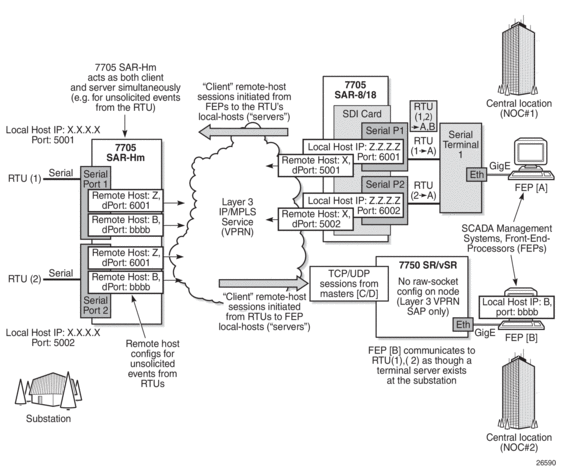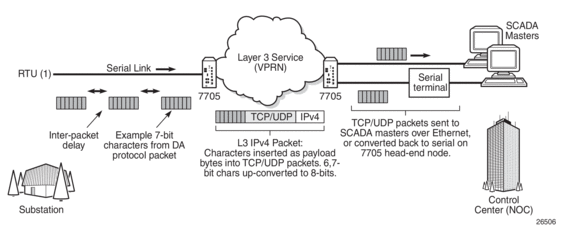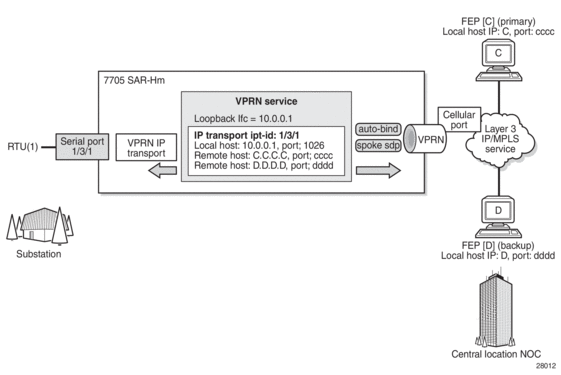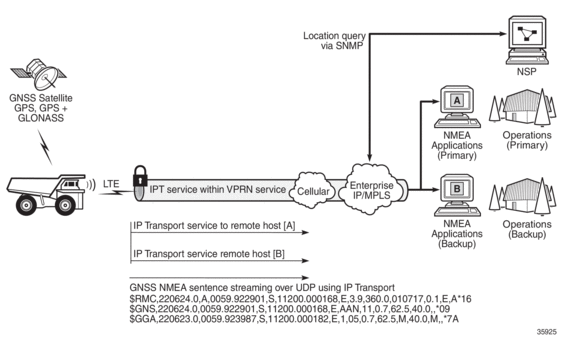9. Layer 2 and Layer 3 Services
The 7705 SAR-Hm series of routers support the services listed below:
- Layer 2 services:
- Layer 3 services:
9.1. Virtual Leased Line (VLL) Services
For general information on VLL support, refer to the topics listed below in the “VLL Services” chapter of the 7450 ESS, 7750 SR, 7950 XRS, and VSR Layer 2 Services and EVPN Guide: VLL, VPLS, PBB, and EVPN.
- Ethernet Pipe (Epipe) Services
- Epipe Service Overview
- Epipe Service Pseudo-Wire VLAN Tag Processing
- Epipe Up Operational State Configuration Option
- Pseudo-Wire Redundancy Service Models
- BGP Virtual Private Wire Service (VPWS)
- Single-Homed BGP VPWS
- Dual-Homed BGP VPWS
- VLL Service Considerations
- Configuring a VLL Service with CLI
- Service Management Tasks
For descriptions of VLL services commands, refer to the 7450 ESS, 7750 SR, 7950 XRS, and VSR Classic CLI Command Reference Guide and to the 7450 ESS, 7750 SR, 7950 XRS, and VSR Clear, Show, and Tools Command Reference Guide.
9.2. Virtual Private LAN Service (VPLS)
For general information on VPLS support, refer to the topics listed below in the “Virtual Private LAN Service” chapter of the 7450 ESS, 7750 SR, 7950 XRS, and VSR Layer 2 Services and EVPN Guide: VLL, VPLS, PBB, and EVPN.
- VPLS Service Overview
- VPLS Features
- VPLS Service Pseudo-Wire VLAN Tag Processing
- VPLS MAC Learning and Packet Forwarding
- Pseudo-Wire Control Word
- Table Management
- Split Horizon SAP Groups and Split Horizon Spoke SDP Groups
- VPLS and Spanning Tree Protocol
- VPLS Access Redundancy
- Object Grouping and State Monitoring
- MAC Flush Message Processing
- ACL Next-Hop for VPLS
- SDP Statistics for VPLS and VLL Services
- BGP VPLS
- BGP Multi-Homing for VPLS
- Routed VPLS and I-VPLS
- IES or VPRN IP Interface Binding
- IP Interface MTU and Fragmentation
- ARP and VPLS FDB Interactions
- The allow-ip-int-bind VPLS Flag
- R-VPLS Caveats
- VPLS Service Considerations
- Configuring a VPLS Service with CLI
- Service Management Tasks
For descriptions of VPLS service commands, refer to the 7450 ESS, 7750 SR, 7950 XRS, and VSR Classic CLI Command Reference Guide and to the 7450 ESS, 7750 SR, 7950 XRS, and VSR Clear, Show, and Tools Command Reference Guide.
9.3. Internet Enhanced Service (IES)
For general information on IES support, refer to the topics listed below in the “Internet Enhanced Service” chapter of the 7450 ESS, 7750 SR, 7950 XRS, and VSR Layer 3 Services Guide: IES and VPRN.
- IES Service Overview
- IES Features
- IP Interfaces
- Object Grouping and State Monitoring
- SAPs
- Encapsulations
- Shaping and Bandwidth Control
- Routing Protocols
- QoS Policies
- Filter Policies
For descriptions of IES commands, refer to the 7450 ESS, 7750 SR, 7950 XRS, and VSR Classic CLI Command Reference Guide and to the 7450 ESS, 7750 SR, 7950 XRS, and VSR Clear, Show, and Tools Command Reference Guide.
On the 7705 SAR-Hm series of routers, IES services are supported on Ethernet ports. IES services are not supported over cellular ports or the WLAN interface.
9.4. Virtual Private Routed Network Service (VPRN)
For general information on VPRN support, refer to the topics listed below in the “Virtual Private Routed Network” chapter of the 7450 ESS, 7750 SR, 7950 XRS, and VSR Layer 3 Services Guide: IES and VPRN.
- VPRN Service Overview
- Routing Prerequisites
- Core MP-BGP Support
- Route Distinguishers
- Route Reflector
- CE-to-CE Route Exchange
- Constrained Route Distribution (RT constraint)
- BGP Best-External in a VPRN Context
- VPRN Features
- IP Interfaces
- Traffic Differentiation Based on Route Characteristics
- Associating an FC Priority with a Route
- Displaying QoS Information Associated with Routes
- Object Grouping and State Monitoring
- VPRN IP Interface Applicability
- SAPs
- Encapsulations
- Pseudowire SAPs
- QoS Policies
- Filter Policies
- DSCP Marking
- Configuration of TTL Propagation for VPRN Routes
- CE to PE Routing Protocols
- Spoke SDPs
- IP-VPNs
- Traffic Leaking to GRT
- Traffic Leaking from VPRN to GRT for IPv6
- RIP Metric Propagation in VPRNs
- NTP within a VPRN Service
- VPN Route Label Allocation
- QoS on Ingress Binding
- FIB Prioritization
- Configuring a VPRN Service with CLI
- Service Management Tasks
For descriptions of VPRN commands, refer to the 7450 ESS, 7750 SR, 7950 XRS, and VSR Classic CLI Command Reference Guide and to the 7450 ESS, 7750 SR, 7950 XRS, and VSR Clear, Show, and Tools Command Reference Guide.
9.5. IP Transport Services
This section provides information on the following topics:
9.5.1. Raw Socket IP Transport Service
Serial data transport using raw sockets over IP transport services is a method of transporting serial data, in character form, over an IP network using Layer 3-based services. This feature can help transport Supervisory Control and Data Acquisition (SCADA) data from Remote Terminal Units (RTUs) to Front-End Processors (FEPs), or SCADA masters.
The functionality provided by the IP transport service feature for serial raw sockets is summarized as follows:
- IP transport local host server function, to listen and open raw socket sessions from remote hosts
- IP transport remote host client function, to initiate and open new raw socket sessions to remote hosts
- Both local host and remote host functions support either TCP or UDP IP transport services
- IP transport over a VPRN service
- Enhanced QoS and queuing of sessions to ensure collisions between sessions do not cause serial data to impact RTUs and end-user equipment
Figure 12 illustrates a more detailed view of the local host (server) and remote host (client) functionality that enables multiple communication streams to and from a serial port using raw socket IP transport.
The figure shows a three-node network, a 7705 SAR-Hm (left), a 7705 SAR-8/7705 SAR-18 (top-right) and a 7750 SR/VSR (bottom right). There are two devices, RTU (1) and RTU (2) connected to the serial ports on the 7705 SAR-Hm. The FEP server [A] can reach the RTUs the via socket sessions that originate from the SDI card on the 7705 SAR-8/7705 SAR-18 node.
The bottom right 7750 SR or VSR node is connected to FEP server [B] directly using Ethernet. This FEP server reaches the RTUs via a Layer 3 VPRN service where TCP and UDP sessions originating from the FEP server [B] terminate on the 7705 SAR-Hm to deliver the raw socket serial data to the RTUs.
Through local host and remote host configurations on the 7705 SAR-Hm, 7705 SAR-8, or 7705 SAR-18, serial raw socket IP transport sessions are established to carry serial data over a wireless IP/MPLS network. The source and destination IP addresses and port numbers for these sessions are derived directly from the local/remote host configurations associated with each serial port or master head-end server. Further details are described in the subsequent sections.
Figure 12: IP Transport Service

A raw socket IP transport interface can be configured for each serial port. This allows the raw socket IP transport to receive TCP or UDP session packets from multiple remote hosts when operating as a local host (server), or to create new multiple sessions to remote hosts to send and receive serial data when operating as a client.
There are two main configurations required for a serial raw socket IP transport service to be operational and support the sending and receiving of serial data:
- Port-level socket configuration—This includes rudimentary serial link parameters such as baud rate, start/stop values, and bits.Also, socket-level configuration is required, such as end-of-packet checking parameters (idle-time, length, special character), and the inter-sessions delay for transmitting sessions data out the serial link. For information on the required port-level configuration, refer to the 7705 SAR-Hm and SAR-Hmc Interface Configuration Guide, Command Reference chapter, “Serial Raw Socket Interface Configuration Command Hierarchy”.
- IP transport service-level configuration—This includes creating an IP transport subservice to associate the serial port within a Layer 3 VPRN service, so that TCP/UDP encapsulated serial data can be routed within the corresponding Layer 3 service. The IP transport subservice ID is modeled and created identical to creating SAP IDs under the same service types. IP transport configuration includes IP transport local host items and remote host items, such as TCP timers and sessions controls. These are described further in the sections that follow. Also, see Serial Raw Socket IP Transport Configuration Commands Hierarchy for the required information.
A raw socket IP transport service configured for a serial port allows the IP transport local host to listen to and open raw socket sessions from remote hosts that need to communicate over the serial port, and for each serial port’s local host to initiate and open raw socket sessions to remote hosts when serial data needs to be sent to those remote hosts. The local and remote host functions support TCP or UDP sessions (but not both concurrently) over the VPRN service.
The serial data is received as characters that represent bytes in a packet. These bytes are packetized into Layer 3 TCP/UDP packets that are then transported or forwarded across the IP/MPLS network using the node's Layer 3 VPRN service constructs for routing. Figure 13 illustrates how serial data is encapsulated into TCP/UDP packets and transported over IP/MPLS. When using a cellular port, GRE-MPLS and encapsulations for the service would be included, but this is not shown in the figure.
Figure 13: TCP/UDP Packet Transport Over IP/MPLS

For raw socket packets to be routed within a VPRN service, an IP transport subservice must be configured within a VPRN context. The IP transport subservice context is where users configure local host and remote host information, such as IP addresses and ports for establishing TCP/UDP sessions, and other per-session parameters. TCP/UDP encapsulated serial data is routed within the corresponding Layer 3 VPRN service. Figure 14 illustrates this basic concept.
Figure 14: VPRN IP Transport Service

To create an IP transport subservice, the ip-transport command is used with the corresponding serial port as the ipt-id to bind the serial port SAP to the IP transport subservice. After the IP transport service is created, local host and remote host configurations can proceed. A local host must be configured before remote hosts can be configured.
Each local host uses a local address (from a loopback or local interface configured under the VPRN service context) as the local host IP address (that is, the source IP address in the raw socket packets leaving the node within the VPRN service) of the IP transport subservice associated with the serial port. The local host is used to terminate TCP/UDP sessions from remote hosts. The local host can select either the TCP or UDP protocol for raw socket sessions but not both concurrently.
Multiple remote hosts can be configured under the IP transport subservice associated with the serial port so that each remote host receives the serial data that is received on the serial port. Each remote host has its own remote destination IP address and port value for establishing sessions. The configured remote hosts use the TCP or UDP protocol configured for the IP transport subservice.
| Note: It is not necessary to configure remote hosts when the IP transport service is not originating sessions. If sessions are only established towards the IP transport local host (for example, remote servers polling the local host), the remote host configuration is not necessary. Remote host configurations may still be desirable when using filter-unknown-host. |
IP transport processing of TCP/UDP packets is performed by the CPM task. Filters configured for protecting the CPM need to take into account the raw socket IP transport packets and ensure the filter is not blocking associated IP transport sessions. For example, operators need to ensure interface IP addresses and ports configured on the node are not blocked, and remote host IP/port combinations are not blocked.
| Note: IP transport-to-IP transport raw socket data on the same node is not supported. |
9.5.1.1. Remote Host Manual TCP Connection Check
A manual TCP connection check can be performed for each remote host configured for a raw socket IP transport subservice. When executed by an operator, the TCP connection check attempts to establish a TCP session towards the configured remote host. Only one TCP connection check attempt is made, with a fixed timeout of 5 seconds. If the attempt is successful, the session is torn down immediately without data being sent.
The TCP connection check is initiated in the CLI using the tools>perform>service> ip-transport>remote-host>check-tcp command. The result is displayed in the CLI using the tools>dump>service>ip-transport>remote-host>check-tcp command. Equivalent management is available via SNMP.
If a TCP connection to a remote host already exists due to serial traffic being transmitted, the check returns “successful” without impacting the existing TCP connection.
9.5.1.2. QoS Requirements for IP Transport
Serial raw socket data that is transported using an IP transport service can be DSCP marked at the source node. This allows the source node (local host) of the traffic to mark packets correctly so that downstream nodes prioritize them as needed, and to queue local traffic in the right egress queue based on the classification assigned to the IP transport service.
The node does not support FC classification; instead, it marks the DSCP in packets based on the IP transport subservice DSCP setting. This DSCP setting overrides the DSCP marking that would have otherwise been based on the egress network queue policy FC. These packets will be queued on egress with all other control traffic and will be considered high priority.
Additionally, the DSCP setting is assigned per IP transport subservice for all traffic from the local host and all traffic destined to each remote host. There is no per remote host control for the DSCP setting.
9.5.2. GNSS NMEA Data IP Transport Service
IP transport services are used to send GNSS National Marine Electronics Association (NMEA) data to remote hosts. All IP transport functionality supported for serial data over raw sockets is also available for NMEA data. See Raw Socket IP Transport Service for information.
An IP transport subservice within a Layer 3 VPRN service can be configured to transmit GNSS NMEA data from the GNSS receiver (as the IP transport local host) to one or more remote hosts. See Figure 15. Any packets sent from remote hosts toward the local host of the IP transport subservice are dropped.
Figure 15: GNSS NMEA Data Over IP Transport Service

Use the syntax shown below to create an IP transport subservice within a VPRN service.
To enable the transport of NMEA data from the local host, configure the ipt-id as gnss. The following example is an IP transport subservice configuration output for the transport of NMEA data.
For information about configuring NMEA parameters on the GNSS receiver, refer to the 7705 SAR-Hm and SAR-Hmc Interface Configuration Guide, “GNSS Configuration”.
9.5.3. Serial Raw Socket IP Transport Configuration Commands Hierarchy
9.5.3.1. IP Transport Configuration Command Descriptions
ip-transport
Syntax
Context
Description
This command creates an IP transport subservice within a VPRN service. An IP transport subservice can be used to transmit serial raw socket data to and from a local host and remote host. An IP transport subservice can also be used to transmit GNSS NMEA data from the GNSS receiver to one or more remote hosts.
All IP transport subservices must be explicitly created using the create keyword. An IP transport subservice is owned by the service within which it is created. An IP transport subservice can only be associated with a single service. The create keyword is not needed when editing parameters for an existing IP transport subservice. An IP transport subservice must first be shut down before changes can be made to the configured parameters.
The no form of this command deletes the IP transport subservice with the specified ipt-id. When an IP transport subservice is deleted, all configured parameters for the IP transport subservice are also deleted.
Default
no ip-transport
Parameters
description
Syntax
Context
Description
This command creates a text description for a configuration context to help identify the content in the configuration file.
The no form of this command removes any description string from the context.
Default
no description
Parameters
dscp
Syntax
Context
Description
This command configures the DSCP name used to mark the DSCP field in IP transport packets originating from this node.
Default
ef
Parameters
Table 6: Valid DSCP Names
dscp-name |
be, ef, cp1, cp2, cp3, cp4, cp5, cp6, cp7, cp9, cs1, cs2, cs3, cs4, cs5, nc1, nc2, af11, af12, af13, af21, af22, af23, af31, af32, af33, af41, af42, af43, cp11, cp13, cp15, cp17, cp19, cp21, cp23, cp25, cp27, cp29, cp31, cp33, cp35, cp37, cp39, cp41, cp42, cp43, cp44, cp45, cp47, cp49, cp50, cp51, cp52, cp53, cp54, cp55, cp57, cp58, cp59, cp60, cp61, cp62, cp63 |
filter-unknown-host
Syntax
Context
Description
This command filters connections from unknown hosts. An unknown host is any host that is not configured as a remote host.
The no form of this command disables the filter.
Default
no filter-unknown-host
local-host
Syntax
Context
Description
This command creates the local host within the IP transport subservice.
The local host is required to accept TCP/UDP sessions initiated from far-end remote hosts, and for the node to initiate sessions towards the far-end remote hosts.
| Note: When the IP transport ID is configured as gnss, any packets sent from remote hosts to the local host are dropped. |
The local host must be created before a remote host is created.
The no form of this command deletes the local host.
Default
no local-host
Parameters
remote-host
Syntax
Context
Description
This command creates a remote host within the IP transport subservice. Multiple remote hosts can be created in order to send serial raw socket date or GNSS NMEA data to remote destinations. The create keyword must be used for each remote host that is created.
The no form of this command deletes the remote host.
Default
no remote-host
Parameters
name
Syntax
Context
Description
This command configures a unique name for this remote host.
The no form of this command deletes the remote host name.
Default
n/a
Parameters
shutdown
Syntax
Context
Description
This command administratively disables an entity. When disabled, an entity does not change, reset, or remove any configuration settings or statistics.
The operational state of the entity is disabled as well as the operational state of any entities contained within. Many objects must be shut down before they can be deleted.
The no form of this command administratively enables an entity.
Default
no shutdown
Special Cases
It is not possible to make configuration changes to an IP transport subservice without performing a shutdown first.
The operational state of an IP transport subservice is relative to the operational state of the serial port or GNSS receiver for which the IP transport subservice is defined. When a serial port or GNSS receiver is shut down, the IP transport subservice associated with the serial port or GNSS receiver becomes operationally down.
When the no shutdown command is executed for an IP transport subservice, it becomes operationally up. Serial data from the serial port or NMEA sentence data from the GNSS receiver is encapsulated in TCP/UDP packets destined for remote hosts, and TCP/UDP packets can be received by the local host, where raw serial data is then sent out the serial port.
tcp
Syntax
Context
Description
This command creates the context to configure TCP parameters within this IP transport subservice.
Default
n/a
inactivity-timeout
Syntax
Context
Description
This command specifies how long to wait before disconnecting a TCP connection due to traffic inactivity over the connection.
Default
30 s
Parameters
max-retries
Syntax
Context
Description
This command specifies the number of times that a remote host, acting as a client, tries to establish a TCP connection after the initial attempt fails.
Default
5
Parameters
retry-interval
Syntax
Context
Description
This command specifies how long to wait before each TCP max-retries attempt.
Default
5 s
Parameters
9.5.4. IP Transport Show Commands Hierarchy
9.5.4.1. IP Transport Show Commands Descriptions
id
Syntax
Context
Description
This command displays information for a particular service ID
Parameters
ip-transport
Syntax
Context
Description
This command displays information for a specified IP transport subservice within this service. If no IP transport subservice is specified, summary information is displayed for all IP transport subservices associated with the service.
Parameters
Output
The following output is an example of IP transport subservice summary and detailed information for a specified service.
remote-host
Syntax
Context
Description
This command displays information for a specified remote host within this IP transport subservice within this service. If no remote host is specified, summary information is displayed for all remote hosts within this IP transport subservice.
Parameters
Output
The following output is an example of IP transport subservice remote host summary and detailed information.
ip-transport-using
Syntax
Context
Description
This command displays IP transport subservice information for a specified port. If no port is specified, the command displays a summary of all IP transport subservices defined for this service.
Parameters
Output
The following output is an example of ip-transport-using information.
9.5.5. IP Transport Clear Commands Hierarchy
9.5.5.1. IP Transport Clear Commands Descriptions
id
Syntax
Context
Description
This command clears commands for a specific service.
Parameters
ip-transport
Syntax
Context
Description
This command clears IP transport statistics for this service.
Parameters
remote-host
Syntax
Context
Description
This command clears statistics pertaining to a specified remote host assigned to this IP transport subservice.
Parameters
statistics
Syntax
Context
Description
This command clears statistics-related information pertaining to all configured IP transport subservices or to all configured remote hosts for a specified IP transport subservice.